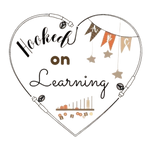
Open Ended Loose Parts Play - Wooden vs 3D Printed - By Lydia
Loose parts play has been gaining traction and popularity lately but contrary to the bright, happy, interactive musical or battery-operated learning toys you can get from large departmental stores, these toys are often singular in colour, plain, basic, and certainly don't come with any bells and whistles. From the off start, it doesn’t look like it will provide any ‘learning opportunities to a child in comparison to that new alphabet app on the iPad. So why invest in it?
I invite you to join in the conversation with me. I’m a mum of 3, recently blessed to be SAHM after baby no.3. I’m not an educator, so you will be hearing genuine words from a mum who is contemplating life out of childcare. What do I do with my toddler now that I’m not putting her into full time childcare like I did with her older brothers when I used to work full-time? How do I try to engage her in some fun learning? That’s when I found out about loose parts play.

In 1972, architect and artist Simon Nicholson developed the Theory of Loose Parts; the idea that loose parts, materials which can be moved around, designed, and redesigned and tinkered with; create infinitely more opportunities for creative engagement than static materials and environments.
But what does this mean for our children? Sustained and focused learning is often observed as children engage in loose parts play. When children interact with loose parts, they enter a world of ‘what if’ that promotes the type of thinking that leads to problem-solving and theoretical reasoning, loose parts enhance a child’s ability to think imaginatively and see solutions. Additionally, they bring a sense of adventure and excitement to play. I also use them to teach her early numeracy, counting, colours and grouping. Loose parts can also be used for a long time! I use loose parts even for my higher primary child, helping him visualize mathematical concepts in advanced counting, groups, 3D objects, volume etc.
What kind of loose parts should you use? Honestly, the sky's the limit. There are many good educational shops, both brick and mortar, and online that carry good quality loose parts, such as the wooden parts from Grapat and the 3D bioplastic shapes from Treasure Trunk. But you can also easily have a treasure hunt and pick up loose parts from the garden, pebbles and rocks, feathers, branches, flowers, leaves, bark etc. Loose parts have no instructions and no predetermined rules. I guess what you use depends on where you are, what you prefer or what kind of play you are planning.
Today I would like to take the chance to compare the Wooden Loose Part from Grapat and the 3D Bioplastic Cones from Treasure Trunk. I love having a collection of these commercially made parts at home for a few simple reasons.
- They store well (I know that will not still disintegrating like loose parts collected from nature).
- They are equal sized parts in each box. This really helps when we want to include them in a building project.
- Easy to get out.
- Works will with various play set ups at home.

Open Ended Loose Parts Play (Wooden vs 3D Printed)
Both the wooden parts and 3D bioplastic parts are amazing but I’m comparing them just because 3D printed parts are new in the market. Are 3D printed toys subpar to the popular wooden loose parts?
Not at all. I will compare them both in 3 easy points below:
1) Texture
Both wooden and 3D printed parts are textured. This means they are easy to grasp with little hands. Grapat colour stains its product instead of painting it. This retains the beautiful wood grain feel. The 3D bioplastic parts are also textured, like what you would expect from a 3D printed product. This gives it a lovely textured feel as well that is perfect for little hands at play.
2) Usage
Both the wooden and 3D bioplastic parts can be used in the same way. They are both good quality and hardy products that will last the span of time. However wooden parts cannot be used in wet or water play as that can damage the natural wood. The 3D bioplastic parts however, do not have such limitations. We love using it in playdough play, in wet water play setups and even poking holes in the garden. It washes off quickly and easily.
3) Cost
Currently the 3D printed bioplastic parts are slightly more expensive than the Grapat wooden parts. But as mentioned above it can be used in more play applications and as demand for 3D printed toys increases, we will have better cost effectiveness.


Leave a comment